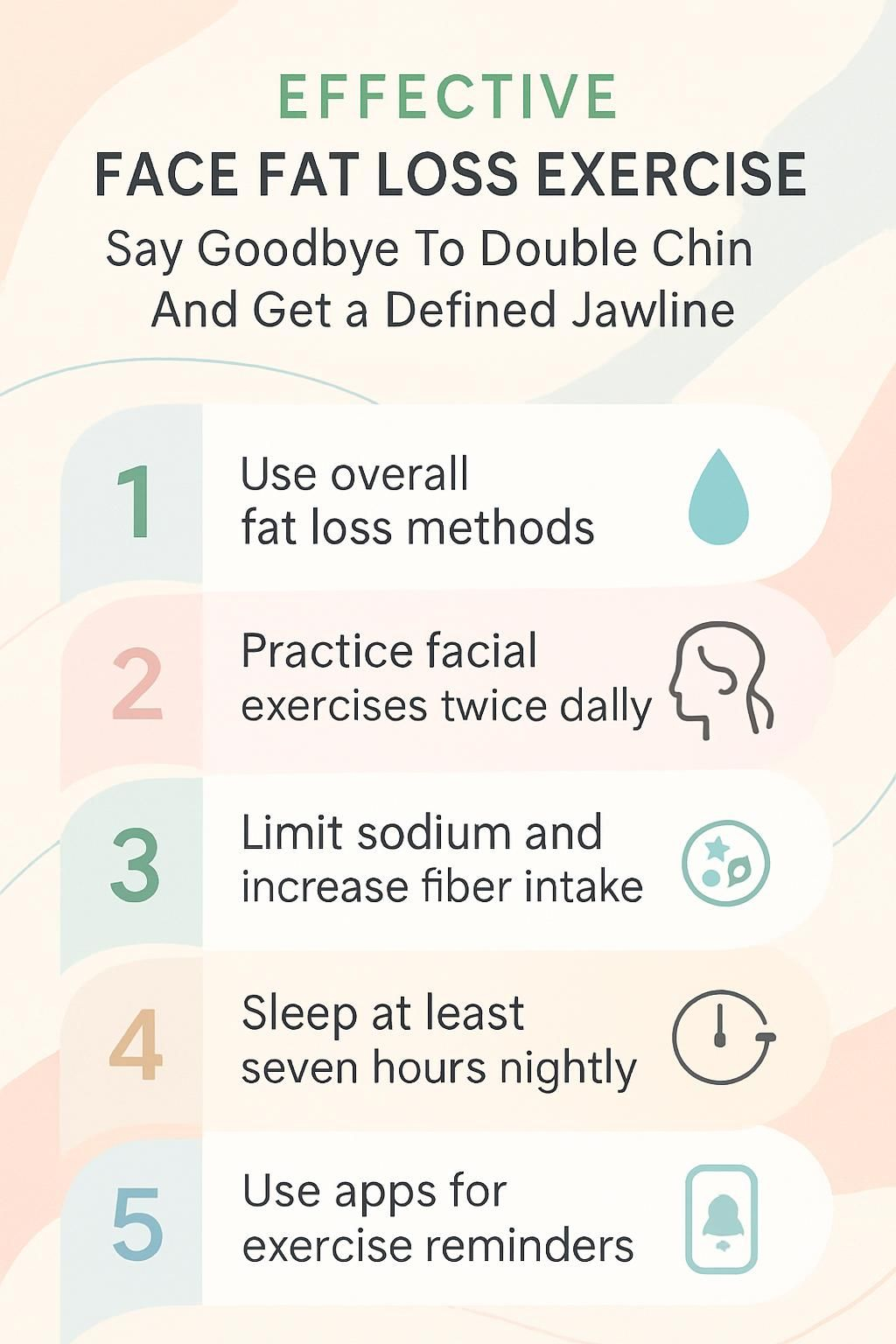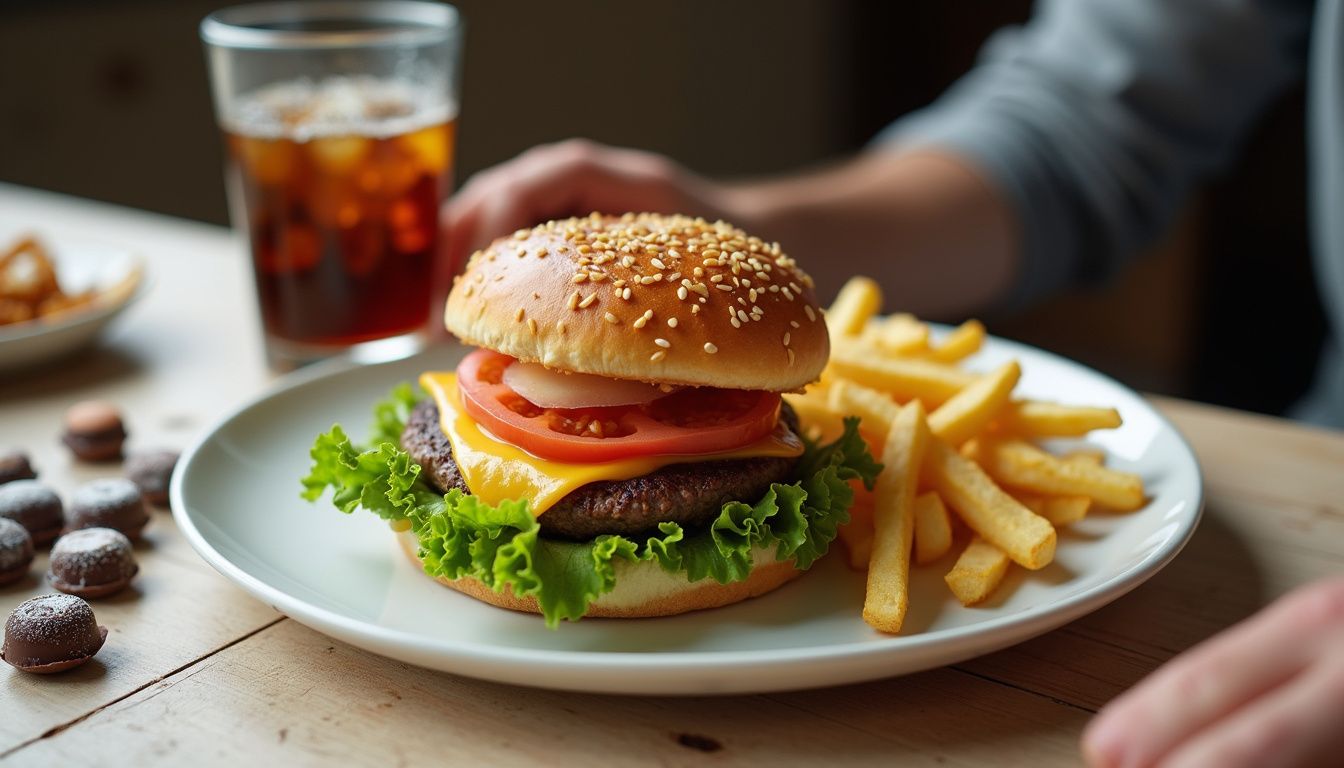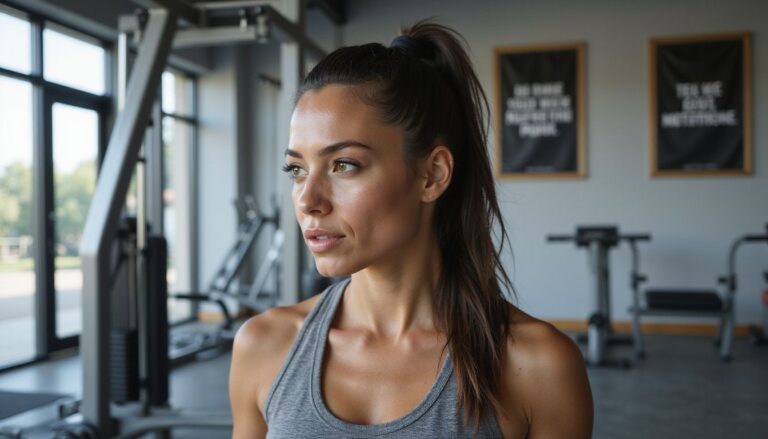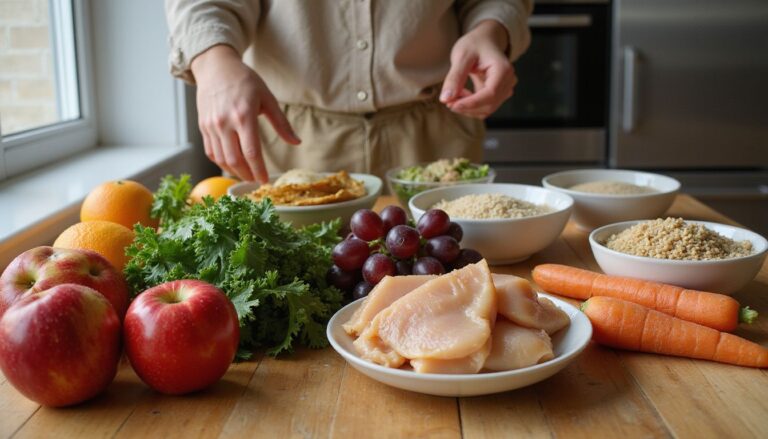Effective Face Fat Loss Exercise: Say Goodbye To Double Chin And Get A Defined Jawline
Our Nutrition Assistant AI Suite will transform your body. You will lose fat, get toned, and build muscle. Gain confidence and optimal health.
Struggling with a double chin or trying to make your face look slimmer? Targeted facial exercise can help tone muscles in your cheeks, chin, and neck, which may make face fat less noticeable.
This guide explains why facial fat builds up, what exercises help, and which daily habits speed results. You will also learn the limits of spot reduction and how to combine fitness, sleep, and nutrition for a sharper jawline.
Key Takeaways
- Spot reduction is a myth; aim to lower body fat with balanced meals, aerobic exercise, and strength training per National Institutes of Health guidance.
- Chin lifts and cheek puffs, 30 seconds twice daily for 8 weeks, can increase muscle thickness under the chin, according to a 2021 review.
- Cut sodium from processed foods, raise fiber to about 30 g for men and 21 g for women over 50, and choose whole grains to reduce facial puffiness.
- Adults need at least 7 hours of sleep nightly, says the CDC; poor sleep raises cortisol, slows metabolism, increases cravings, and can worsen puffiness.
- Apps like JAWLINE EXERCISES – FACE YOGA provide reminders that help you stay consistent and build confidence as jawline definition improves.

Causes and Facts About Face Fat

Your face often shows body changes first. Extra weight, water retention, and genetics can make your cheeks and jawline look fuller.
What causes fat to accumulate in the face?
Weight gain can appear early in your face, creating a double chin or rounder cheeks. Aging shifts fat pads and lowers muscle tone. Metabolism, the rate your body burns energy, slows with time, especially after age 50.
Some areas lose volume while the jaw and under-chin area may store more fat. High-sodium diets from packaged foods cause water retention and puffiness. Hormonal changes, certain medical conditions, and family history also play a role.
Skin loses collagen, a protein that gives structure and firmness, as you age. That change softens facial contours. I noticed my face looked rounder after a small weight gain, long before my clothes felt tight.
Excess calories, low activity, and frequent processed foods make fullness more visible. These factors matter, yet spot reduction is a myth. You need a full-body plan to slim the face.
Can you lose face fat through spot reduction?
Targeting fat loss in a single area does not work. Doing only cheek or chin exercises cannot force fat loss there. Fat is lost through a whole-body process driven by diet, movement, sleep, and genetics.
For safe progress, NIH suggests losing about 1 to 2 pounds per week for up to 6 months. Rapid loss can reduce facial volume too fast, which some call “Ozempic face.” Age, genetics, and health affect how your face responds.
Your body chooses where fat comes off first, and that pattern varies by person. My cheeks leaned out only after several weeks of steady training and better meals, even though other areas changed sooner.
Build habits you can maintain. Patience and consistency are what change your face shape over time.
Spot reduction is not possible; long-term diet and lifestyle changes are key for losing facial fat, explains Dr. Saltzman.
Benefits of Reducing Face Fat
Lowering facial fullness can shrink a double chin and sharpen your jawline. Many people feel more confident once their natural structure shows again.
How does reducing face fat improve facial definition?
Losing excess fullness reveals cheekbones and separates the chin from the neck. Your features look cleaner and more sculpted.
A 2021 research review reports that facial exercises can enhance muscle tone and support facial rejuvenation. In my case, two months of chin lifts and cheek puffs, 30 seconds twice a day, made the area near my jaw feel firmer and look more defined.
Small wins add up. Sharper lines around your jaw encourage you to stick with the plan.
How can a slimmer face boost your confidence?
Clearer definition often changes how you feel in photos, calls, and daily life. People who use simple routines, including facial exercise, often report higher self-esteem when they notice results and positive feedback.
The “JAWLINE EXERCISES – FACE YOGA” app can send nudges that help you keep going on busy days, which supports confidence and progress.
When you feel good about how you look, confidence follows in every part of your life.
Hearing that your face looks slimmer can brighten your mood. Many users also feel more in control because the mirror reflects their effort.
What overall appearance benefits come from losing face fat?
A slimmer face can look more youthful and awake. Defined cheekbones and a clearer jawline draw attention to your eyes and smile.
Good hydration and a higher fiber intake help maintain skin elasticity and reduce bloating. Cutting processed foods made a noticeable difference for me. My face looked less puffy, and my jawline stood out more.
Keeping sodium in check and drinking enough water support a brighter, toned look. Lower body fat also benefits your health beyond the mirror.
Effective Facial Exercises for Face Fat
Facial exercises strengthen key muscles in your cheeks, jaw, and neck. They are quick to learn and easy to fit into your day.
How do chin lifts help reduce face fat?
Chin lifts work the muscles under the chin and along the jaw. Tilt your head back, lift your chin toward the ceiling, and hold steady. Studies report that 30 seconds, twice a day, for 8 weeks can increase muscle thickness beneath the chin.
Stronger muscles improve tone and can reduce the look of a double chin. That is why many apps, including JAWLINE EXERCISES – FACE YOGA, include chin lifts in short daily drills.
After adding them to my morning routine, my jawline looked firmer within two months. Consistency matters most.
What are cheek puffs and how do they work?
Cheek puffs target your cheek muscles. Fill one cheek with air, move it to the other cheek, and keep switching for about 30 seconds. Do this twice a day.
Regular practice builds endurance in those muscles. I first tried cheek puffs after a video tutorial and felt more tightness along my lower face within weeks.
Engaging facial muscles may help your face look slimmer as part of a full plan, which includes smart eating and hydration. This move needs no gear and fits into a small time window.
Can lip puckers tone your facial muscles?
Yes. Lip puckers work the muscles around the mouth and jaw, including the orbicularis oris. Gently pucker your lips in and out. Hold each pucker for a few seconds.
People who perform these moves daily often notice firmer skin near the mouth and jawline after several weeks. Use slow, controlled motions to avoid strain.
Combine puckers with cardio, protein-rich meals, and water. That mix supports fat loss across the body and a cleaner jawline.
How do tongue stretches target face fat?
Tongue stretches engage muscles beneath the chin. Press your tongue to the roof of your mouth, then extend it outward as far as comfortable. You should feel a gentle tension.
The JAWLINE EXERCISES – FACE YOGA app provides step-by-step guidance to nail the form. These drills may reduce puffiness from dehydration or a salty meal when used with healthy daily habits.
Keeping them in your rotation supports jaw definition and better weight management.
What benefits do neck rolls provide for the face?
Neck rolls stretch and strengthen muscles in the neck and lower face. That helps tighten the area under your chin and can reduce the look of a double chin.
Regular engagement in this region supports toning. Many trainers also recommend neck rolls to improve circulation, which may lessen swelling from inactivity.
Stronger neck muscles support posture and appearance. This small habit helps highlight your jawline over time.
Facial Yoga Techniques for a Defined Jawline
Think of facial yoga as gentle strength training for your face, with moves that fit into a coffee break.
How does the cheek lifter exercise shape your face?
The cheek lifter targets muscles along your cheeks and upper lip. Lift your top lip to raise the cheeks, then hold and release.
Consistent practice supports a lifted look and tighter skin. Using tools like the “JAWLINE EXERCISES – FACE YOGA” app can help you stay on track.
Stronger cheek muscles can make your cheekbones “pop,” which draws attention away from a soft jawline.
What is the fish face exercise and its benefits?
Make a fish face by pursing your lips and drawing the cheeks inward. Hold 5 to 10 seconds, then relax. Repeat a few times.
This move tones muscles in the cheeks and jaw area. When paired with whole-body weight loss, it may help your face look slimmer.
Many people also find that a routine with regular movement helps them feel fuller longer and reduces salty snack runs at night.
How does the big “O” stretch help define your jawline?
Open your mouth into a wide “O” shape. This engages lower face and jaw muscles that often weaken with long hours at a desk.
Practiced often, the big O can improve muscle tone and reduce sagging. Best results come when you mix facial moves with healthy meals and regular training.
No equipment is needed, which makes it easy to repeat daily.
What is the puff and release technique in facial yoga?
Fill your cheeks with air, hold for a few seconds, then release. This improves blood flow and activates facial muscles without strain.
People use this technique to counter puffiness and soften under-chin fullness. Practicing it after waking helps my face feel less puffy before early meetings.
Pair puff and release with chin lifts or cheek puffs. The combination can speed visible definition along your jaw.
Lifestyle Changes to Support Face Fat Loss
Simple daily choices shape your results. Small changes done consistently can slim your face and support a clear jawline.
How does a healthy diet affect face fat loss?
Balanced meals help control calories and reduce swelling. Focus on whole foods, lean protein, and produce. Limit snacks and sugary drinks that raise intake fast.
- Choose whole grains instead of refined grains.
- Load half your plate with vegetables or fruit.
- Include protein at each meal to curb hunger.
- Keep salty packaged foods rare.
Fiber from fruits, vegetables, beans, and whole grains helps you feel full and is associated with increased weight loss. Swapping refined carbs for whole grains also dials down puffiness.
Protein plus fiber keeps you satisfied, which makes it easier to eat less and slim your face as body fat drops.
Why is staying hydrated important for reducing face fat?
Water helps manage appetite and supports a healthy metabolism. Replacing sugary drinks with water before meals led to about 5 percent average weight loss over 12 weeks in a 2019 review.
Hydration reduces facial swelling by flushing excess sodium. It also helps skin stay elastic, which supports a cleaner contour during weight loss.
Drinking water before meals can lower calorie intake. That is a simple step that supports facial toning and sharper lines.
How does getting enough sleep support a slimmer face?
Adults need at least 7 hours per night, according to the CDC. Too little sleep raises cortisol, a stress hormone that encourages fat storage, and it also disrupts ghrelin and leptin, which control hunger and fullness.
That mix can trigger carb cravings and extra snacking. Poor sleep also slows how your body uses energy, which makes puffiness more likely.
Set a steady sleep schedule, limit late screens, and keep your room dark and cool. A rested body burns calories more efficiently and shows less morning swelling.
Dietary Tips for Slimming Your Face
Food choices can help reduce facial puffiness and support steady fat loss. Aim for clarity, not perfection.
Why increase fiber and protein to reduce face fat?
Higher fiber intake is linked to weight loss in many studies. One 2020 review across 62 studies found that more soluble fiber reduced body weight and waist size, even without strict calorie cuts.
AARP’s Whole Body Reset plan highlights getting enough protein at each meal to maintain muscle while losing fat. That helps your jawline look firm, not saggy.
Good options include beans, lentils, eggs, yogurt, poultry, fish, and whole grains. These staples support weight management without crash diets or surgery.
How do refined carbs and sugar impact face fat?
Refined carbs, such as cookies and white pasta, break down quickly into sugar. That spike can increase insulin and encourage fat storage, including in the face.
People who choose more whole grains, like brown rice and oats, tend to gain less fat over time. Swap white bread for whole grain bread and you may notice less facial puffiness within weeks.
Steady energy beats sugar highs and lows. Your face will show the difference.
What role does sodium intake play in facial puffiness?
Too much sodium makes your body hold water. More than three-quarters of the sodium you eat comes from processed foods like chips, canned soups, and fast food.
This extra fluid often settles in the cheeks and under the eyes. After I cut salty snacks and chose fresh meals, my face looked noticeably less puffy.
Read labels, cook more at home, and flavor with herbs, citrus, and spices. Your jawline will thank you.
Cardio and Strength Training for Full-Body Fat Loss
Think of exercise as your dial for steady fat loss. As body fat drops, your face usually reflects the change.
What are the benefits of cardio exercises like running or swimming?
Cardio raises your heart rate and burns calories quickly. A 12-week program of aerobic exercise, such as running or swimming, can reduce body fat percentage and waist size.
When total fat decreases, the face often appears slimmer. My regular swim sessions led to visible changes after a few weeks of steady practice.
Pick activities you enjoy, then schedule them like appointments. Consistency beats intensity.
How does strength training help reduce fat and boost metabolism?
Strength training builds muscle using resistance, such as dumbbells or bands. The CDC recommends muscle work at least two days per week in addition to cardio.
Muscle burns more calories than fat at rest. Increasing lean mass raises daily energy use, which helps reduce body fat and can sharpen facial features.
This is especially helpful as you age. Preserving muscle supports a youthful shape in the lower face.
Habits to Avoid for Reducing Facial Puffiness
Certain habits make puffiness stick around. Cutting them down can speed results from your routine to slim the face.
Why should you limit alcohol consumption to reduce facial puffiness?
Alcohol acts as a diuretic, which dehydrates you. Your body then holds onto fluid, and your face can look swollen the next day.
Even moderate drinking can cause puffiness and adds empty calories. Alcohol also nudges you toward salty or sugary foods that worsen swelling.
Many clients who cut back noticed a sharper jawline within weeks. Your liver handles toxins and fat processing, so easing that load helps your results.
How do processed foods contribute to a puffy face?
Processed foods usually pack sodium, added sugar, and unhealthy fats. That combination leads to water retention and weight gain, which can show up as a bigger double chin.
I saw this myself after a run of frozen dinners. Switching to fresh, lower-sodium meals reduced my facial swelling and shine.
Keep a short list of easy, whole-food meals for busy nights. That small shift pays off quickly.
Common Myths About Losing Face Fat
Myths slow progress and waste effort. Clear facts make your plan simpler.
Is it possible to lose fat only in your face?
No. Research shows you cannot target fat loss in one spot. The face trims down as part of total weight loss that comes from diet quality, movement, sleep, and stress control.
You might see your jawline change early or late, depending on genetics. The reliable path is the same: balanced meals, cardio, and strength work.
Those habits deliver a slimmer face with fewer setbacks.
Does chewing gum really help reduce face fat?
Chewing gum works the masseter muscle, but it does not burn many calories. Evidence that it reduces face fat is weak.
One small study in 2018 showed slight increases in masseter thickness after weeks of gum chewing. It did not reduce fat.
Focus on methods that work: nutritious meals, hydration, exercise, and sleep. That is the dependable route to a defined jawline.
How Long Does It Take to See Results?
Some people notice changes in a few weeks. Lasting definition usually takes steady effort across several months.
What are realistic expectations for face fat loss?
Fat loss in the face mirrors the pace of full-body change. A 20-week facial exercise program in middle-aged women showed visible improvements in the mid and lower face.
Aim for about 1 to 2 pounds per week to protect skin elasticity and shape. Extreme diets can cause loose skin and short-term results.
Keep goals specific and doable. Small wins, repeated daily, reshape your face with less stress.
Why is consistency important in losing face fat?
Muscles strengthen with regular practice. Evidence-based guidance suggests 30 seconds twice daily for at least 8 weeks to see measurable muscle changes.
Apps like JAWLINE EXERCISES – FACE YOGA encourage streaks and proper form. Skipping days slows progress. Pair consistent practice with 8 effective tips to lose puffiness, such as sleep, hydration, and lower sodium.
Stay steady and patient. The mirror will catch up.
Frequently Asked Questions About Face Fat Loss
These quick answers address common concerns so you can move forward with clarity.
Can everyone benefit from facial exercises?
Most people can. Studies show adults, including middle-aged women, see better muscle tone and a fresher look with a guided routine.
In my experience, firmer cheeks and a clearer jawline can appear within weeks. People managing alcoholism may also see less puffiness as they improve hydration and nutrition.
Are there risks to doing too many facial exercises?
Yes. Overuse can cause muscle fatigue, soreness, or swelling, especially if you repeat the same motion without rest. Evidence is still limited, so moderation helps.
Check in with a healthcare professional if you have jaw pain, TMJ concerns, or medical conditions. I once pushed too hard and felt tightness. Good form and recovery resolved it.
Conclusion
A defined jawline is the result of steady habits. Use short facial exercises, regular cardio, and strength training to reduce body fat and make your face look slimmer.
Drink water, sleep at least 7 hours, and keep sodium in check to limit puffiness. Choose fiber and protein at meals to support weight loss and muscle retention. These strategies help get rid of double chin as part of total change, not as a stand-alone fix.
This content is educational and not medical advice. If you have sudden swelling, pain, or a health condition, consult a qualified clinician.
Stay consistent, track small wins, and adjust as needed. With time and patience, face fat decreases and your natural structure takes center stage.
FAQs
1. What are the most effective facial exercises for reducing face fat and getting a defined jawline?
Facial movements such as chin lifts, neck stretches, and cheek puffing can help tone muscles in the lower face. Research published in JAMA Dermatology found that regular practice of targeted facial activities over 20 weeks led to improved muscle thickness and firmer appearance in adults aged 40 to 65.
2. Can diet changes support face fat loss along with exercise?
A balanced eating plan low in processed sugars and high in lean proteins, fruits, and vegetables supports overall body fat reduction. According to data from the Centers for Disease Control and Prevention (CDC), losing total body weight through healthy nutrition often leads to visible changes around the cheeks and jaw.
3. How long does it take to see results from these exercises?
Consistent daily practice is key; many people notice subtle improvements within four weeks while more significant definition may appear after two or three months. A personal experience: After adding chin lifts and neck stretches into my routine each morning, I observed less fullness under my chin by week five.
4. Are there risks or limitations with using only facial workouts for double chin reduction?
While targeted routines strengthen underlying muscles, scientific reviews indicate they do not remove subcutaneous fat alone without overall weight management strategies like cardio activity or dietary adjustments. For best outcomes, combine facial toning with whole-body health practices.
Summary: Facial movements like chin lifts can improve muscle tone when practiced regularly alongside a healthy eating plan focused on whole foods rather than processed items. Noticeable results often require several weeks of consistent effort; combining these methods with full-body wellness strategies yields optimal definition along the jawline while minimizing risk of disappointment due to unrealistic expectations about spot reduction alone.







